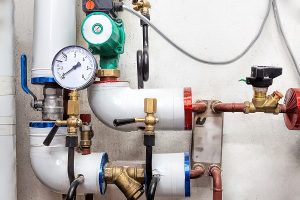
Understanding the difference between water mists and suppression systems is easier than you think!
All business owners need to understand the differences between the two most common sprinkler systems available. Understanding the differences is crucial to fire safety.
What Is A Clean Agent Suppression System?
NFPA Standard 2001 defines a clean agent as: “Electrically non-conductive gaseous fire extinguishant that does not leave a residue upon evaporation. This does not include CO² and water-based agents. The two most popular and well-known clean agents are FM-200™and Novec 1230™. Others include FE-13, FE-25, Nitrogen, Argon, Inergen™, Argonite™ and Halon.
Clean agents are especially suited for data centers, mission critical facilities and to protect sensitive business processes. It’s important to remember that sprinklers are for structure protection and life safety, not total extinguishment. Clean agents and sprinklers have two separate missions. Understanding that critical electronics are extremely vulnerable to fire, it’s very important to remember this distinction. Clean agents reduce the risk of catastrophic damage, protect people and guard against crippling business downtime.
Because clean agent systems are controlled by a network of smoke detectors, they are activated much more quickly that sprinkler systems, which are activated by heat. This is a very important factor to keep in mind when selecting a system. Typical sprinkler heads are rated at 160°F but testing has shown that ceiling temperatures are actually near 600°F when they activate. This is due to “thermal lag”. The destructive effect of a fire and smoke at that temperature is devastating to sensitive electronics.
The two most popular clean agents are FM-200 and Novec 1230. Both agents are stored as a liquid and discharged as a gas. They absorb sufficient heat to extinguish a fire as the gaseous/air mixture has a very high heat capacity. They do not lower oxygen levels in an enclosed space. FM-200 and Novec 1230 have the following common characteristics:
- Low toxicity
- Fast acting, efficient performance
- No residue or collateral damage
- Safe for sensitive electronic equipment
- Accepted and preferred around the world
What Is a Water Mist Suppression System?
Water mist fire suppression systems utilize very fine water droplets, under pressure, to control, suppress or extinguish a fire by cooling the flame and surrounding area by evaporation. The evaporation of water also creates an environment where oxygen is displaced, helping suppress the fire. There are two types of water mist systems.
High-Pressure Water Mist
- High-pressure water mist penetrates a fire in liquid form which results in cooling and evaporation, which controls a fire.
- It is very efficient, using significantly less water than traditional sprinkler systems while achieving a similar or better level of performance.
- Minimizes both fire and water damage and poses no threat to life safety.
- The use of water mist fire suppression, compared to a gaseous agent and traditional sprinkler systems has advantages such as immediate activation, high efficiency in the suppression of a wide range of fires and is environmentally friendly with no toxicity problems.
Hybrid Water Mist
- Hybrid water mist systems are a combination of a clean agent inert gas and water.
- An inert gas, typically nitrogen, is injected into the water stream at the nozzle producing extremely small droplets.
- Hybrid water mist droplets are up to 100 times smaller than traditional water mist systems, providing 50% more improved heat absorption and total extinguishment.
- Hybrid water mist systems leave nearly zero water residue in protected areas.
- There are no room containment issues as with traditional clean agent systems (applies to both types of water mist systems).
- A smoke detection system is required for hybrid water mist systems. This allows for rapid deployment.
Applications
- Marine – Water mist systems are used for their reduced weight and water usage for shipboard fire suppression systems.
- Electric Power Generation – Water mist systems fight a fire in 3 dimensions (height, width, and depth) which are especially useful for turbines, generators, transformers and cable tunnels. This is a more viable option than CO² systems which are a life safety hazard due to oxygen displacement.
- Heavy Industrial – Protects machinery and electrical spaces, conveyors, and assembly lines. Fast activation and no need for containment make these systems an excellent application for this type of hazard.
- Food Processing – The water mist system, utilizing pure water and a high-velocity discharge, is uniquely able to protect large industrial oil fryers and chain type ovens. The system will extinguish the fire with little or no contamination of the food or equipment.
- Data Centers – Hybrid water mist systems produce practically zero wetting of sensitive electronic equipment and computers with no clean-up or hardware replacement. There is no need for sealing of the room and with rapid deployment of the system, early extinguishment will minimize fire damage.
Finding the best system depends on your facility, equipment, and business process. Both types of systems are superior to stand alone traditional sprinkler systems. A complete site and hazard analysis will provide you with the information necessary to make this critical choice.
Get The Best Of The Best From Fireline!
At Fireline, we offer an array of portable fire extinguishers, fire alarms, and sprinkler systems to keep your property safe. Fireline offers the highest quality alarm systems to alert occupants in your business of fires and carbon monoxide poisoning. We also offer fire suppression systems and fire sprinkler systems to keep fires controlled should an incident occur. Our trained sales staff will work with you to determine which system is best for your business and our technicians will ensure a quality installation. Fireline service technicians can test, inspect and repair any existing systems you may have.
To get started with Fireline today, or for more information on fire alarm, sprinkler, or suppression systems call us at 1-800-553-3405 or visit our contact page.
